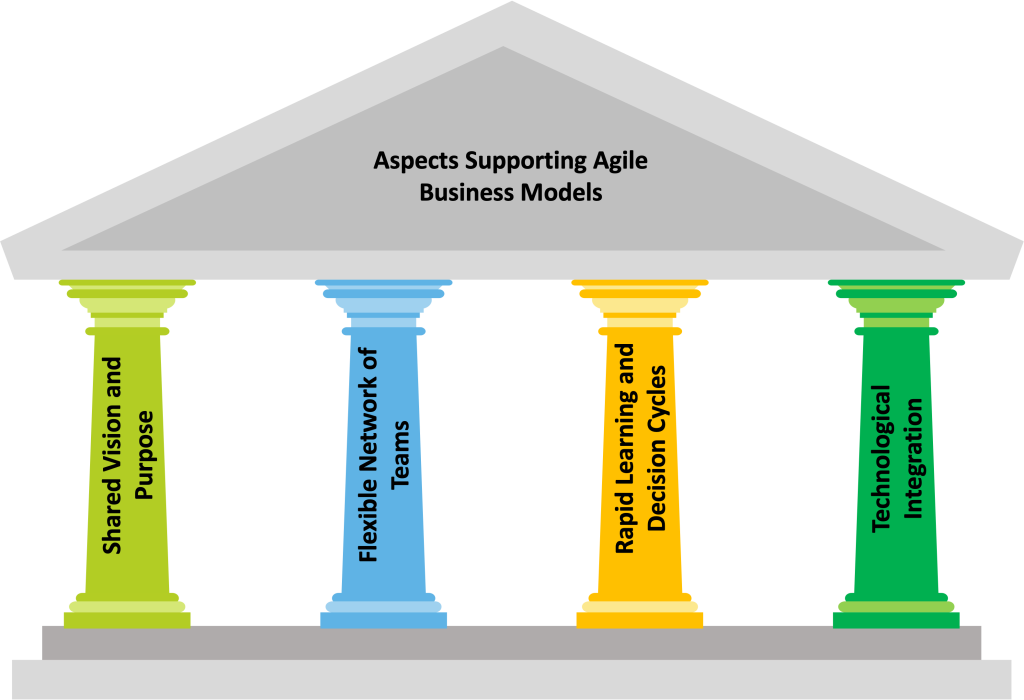
In the current business environment, characterised by rapid technological advancements, shifting consumer behaviours, and global economic uncertainties, agility has emerged as a crucial strategic approach. The rapid evolution of technologies like 5G and AI is transforming business operations and consumer interactions, offering unprecedented data insights and personalisation capabilities. Meanwhile, the dramatic shift towards remote and hybrid work models in response to the pandemic has redefined workplace dynamics and employee expectations.
Agile business models are more than just a set of practices; they represent a fundamental shift in how companies conceive and execute their strategies to thrive in a complex, fast-paced world.
Agile Strategy: A Response to Modern Business Challenges
- Adapting to Rapid Market and Technological Changes:
The agility to navigate evolving technologies, consumer preferences, and market dynamics is crucial. Companies must continuously adapt, leveraging advancements like 5G and AI for data-driven decision-making and enhancing customer experiences.
For example, the integration of 5G in manufacturing and healthcare is revolutionising operations by enabling real-time data processing. For instance, BMW’s use of 5G technology in their Leipzig factory improves real-time tracking of machinery, cars, and tools, significantly enhancing operational efficiency and safety
- Customer-Centricity and Data-Driven Innovation:
Today’s digital landscape demands customer-centric approaches. Agile strategies prioritise leveraging digital tools for personalised services. By integrating customer insights through data analytics, businesses can anticipate market trends and optimise operations.
A prime example is the retail sector’s use of AI to personalise shopping experiences, offering recommendations based on customer data and preferences, thus enhancing customer satisfaction and loyalty.
- Embracing Experimentation, Sustainability, and Ethics:
Agile models emphasise rapid prototyping and iterative development, enabling businesses to respond swiftly to market feedback. Integrating sustainability and ethical considerations reflects growing environmental and social consciousness, aligning with consumer expectations and regulatory compliance.
An example of this is the renewable energy sector, where investments are surpassing those in traditional energy sources, reflecting a commitment to sustainable business practices
- Collaborative Ecosystems and Flexible Organisational Culture:
Agile models foster collaboration beyond organisational boundaries, embracing ecosystems that include other businesses, start-ups, and academia. This approach, coupled with a culture of flexibility, collaboration, and continuous learning, empowers teams to experiment and innovate, essential for growth in a rapidly changing environment.
Google’s collaborations with AI research labs are a testament to this, fostering an environment of continuous learning and innovation.
- Technological Integration and Empowered Teams:
Advanced technologies support agile operations, facilitating real-time communication and AI-enhanced processes. Moreover, agile businesses thrive on networks of empowered teams, enabling rapid responses to environmental changes and challenges.
Companies like Amazon uses advanced data analytics and machine learning to optimise its supply chain and inventory management, demonstrating how technology can enhance agility in business processes.
Key Aspects Supporting Agile Business Models
To effectively implement an agile business model, an organisation must ensure that its structure, culture, and operations are aligned to support agility. This alignment involves several key aspects:

- Shared Vision and Purpose: Agile organisations operate under a collective, unifying vision, often referred to as the ‘North Star’. This shared goal ensures that all parts of the organisation, despite their different functions and processes, work cohesively towards a common purpose. This alignment is crucial for maintaining consistency and direction in an agile environment.
- Flexible Network of Teams: In contrast to the rigid hierarchies of traditional models, agile businesses thrive on a structure of flexible and empowered teams. These teams operate with a high degree of autonomy, accountability, and collaboration. This network model promotes scalability and adaptability, allowing teams to respond rapidly to changes and challenges in their environment.
- Rapid Learning and Decision Cycles: Agile models emphasise quick, iterative cycles for decision-making and learning. These cycles, often referred to as ‘sprints’, enable organisations to rapidly test ideas, learn from outcomes, and make informed adjustments. This approach accelerates the pace of innovation and adaptation, keeping the organisation agile and responsive.
- Technological Integration: Agile organisations require a re-evaluation and integration of advanced technologies that support their agile operations. These technologies, such as real-time communication and work management tools, are essential for maintaining the agility of the business processes and operations.
At Prospectus, we excel in strategy and organisational design, offering expert guidance to businesses adapting to today’s dynamic environment. With our focus is on crafting agile strategies, we help align your organisational structure and culture with strategic goals, ensuring resilience and success amidst the complexities of the modern business landscape.

